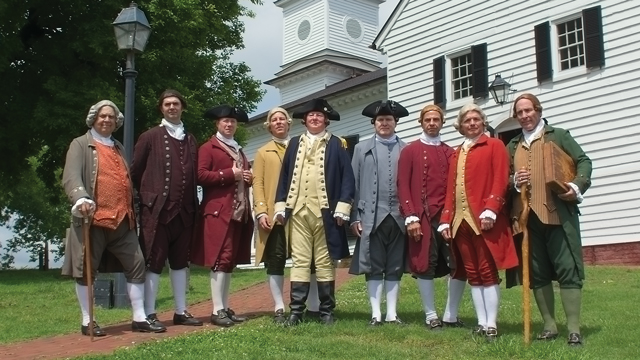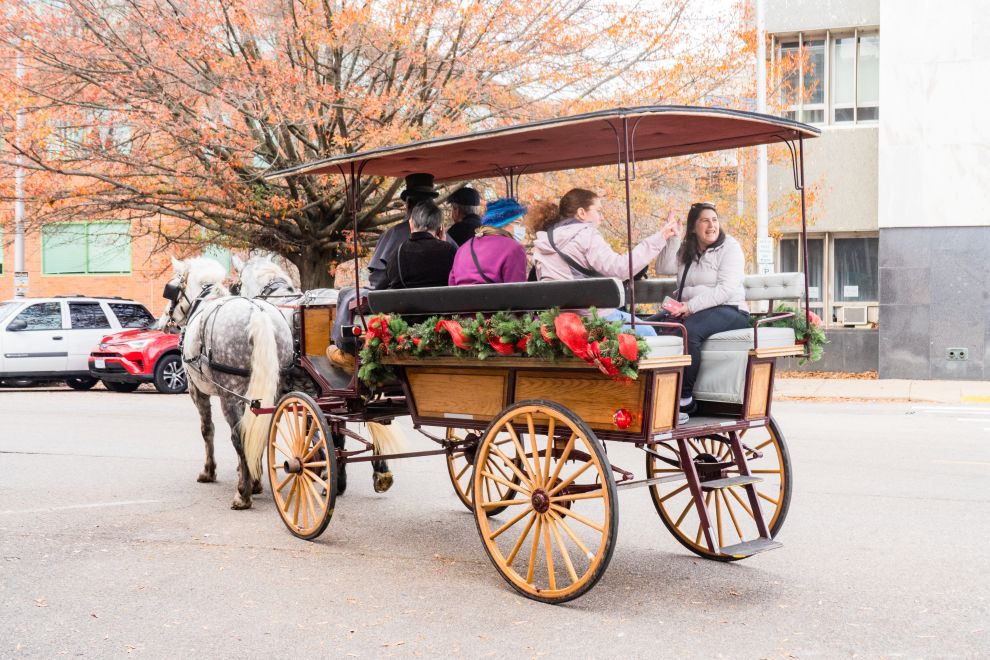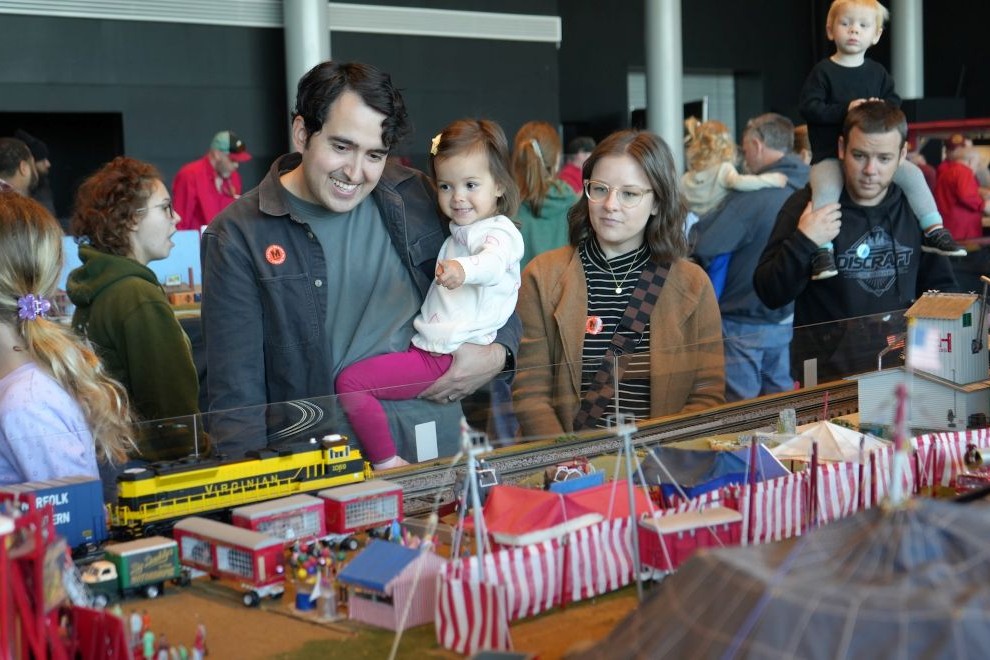It’s amazing how quickly Can’t wait to be home for the holidays! can turn into What’s there to do? Even when family and guests want to spend lots of together time catching up, homes shrink when the weather outside turns frightful – or when everyone starts to become activity-challenged.
Pleasing family members and holiday visitors with the right mix of museums is like trying to make Goldilocks happy. Some people sigh and say they’ve visited larger Richmond museums previously (Virginia Museum of Fine Arts, Science Museum of Virginia); some say they’re saving at least one (The Valentine) until the reopening crowds thin out; and some just want a museum more intimate or off-the-beaten-museum path, or for that matter, on the path toward change.
It’s that last segment that stirred my interest. Even if you’ve visited the five museums covered here within the past three years, you’ll be surprised at the ongoing changes taking place over the next few years at some of them. So read on, but keep in mind that the success of a museum visit often hinges not only on a knowledgeable guide and how well the guide engages different personalities, but also on the background and preparation visitors bring to the museum.
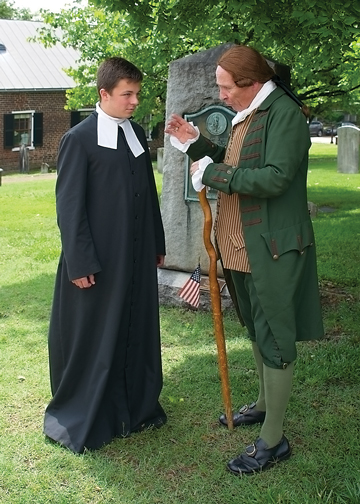
St. John’s Church
Hear Liberty’s Call
Guide Betty Vanderslice spoke softly of Mr. Henry as though he were taking a nap in a pew in the far corner of St. John’s on Church Hill. But the thirty-something visitor from Brazil in our group, Fabiano Moreira, knew very little about Patrick Henry, and a lot about Edgar Allan Poe, commenting that the first Portuguese book he read as a child was a book of his poetry. Moreira was headed to the Poe Museum next, but was intrigued by the notion that Colonial churches fulfilled civic purposes besides those of worship.
Poe’s mother, considered a woman of ill repute because she was an actress, is buried on the grounds of St. John’s Church – not in the part of the cemetery reserved for church members, but in the public cemetery set aside for people who didn’t own property and had no place for burial. St. John’s Church, which is still an active Episcopal congregation, was the site of the first public cemetery in Richmond.
There were many questions the day I visited – some, the same that fourth-graders ask when they visit as part of their study of Virginia history. Most young students know the significance of Jamestown 1607 and the names of several eighteenth-century patriots, but they often don’t know that St. John’s, built in 1741, is the oldest church in the Richmond area, with Henrico Parish (to which it originally belonged) being one of the oldest parishes in America, dating to 1611. Decades after Richmond was chartered in 1742, the twenty-five by sixty-foot shoebox-shaped church was the largest place for the 120 delegates to convene outside of Williamsburg for the Second Virginia Convention on March 23, 1775, the date of Patrick Henry’s “Liberty or Death” speech.
Since 1976, St. John’s Church Foundation has presented historical reenactments at this original location of the convention. People of all ages sit mesmerized as nine costumed actors seated in the pews portray leading Colonial delegates who debate the pros and cons of independence from Great Britain – and then wait to hear why Patrick Henry feels compelled to resist the Crown so forcefully.
St. John’s exterior is in need of paint, and anyone straining to see the face in the sunburst on the underside of the sounding board above the pulpit – as pointed out by Vanderslice – has to use more than a little imagination. The Legacy of Liberty Preservation Project for repairs to this National Historic Landmark, has raised more than two-thirds of its goal of $324,000. Visitors can look for improvements in the future.
401 East Broad Street, Richmond
804-649-7938
historicstjohnschurch.org
Reenactments are free, but a $5 donation is suggested.
Daily church tours, $6 per visitor.
photo courtesy: St. John’s Church
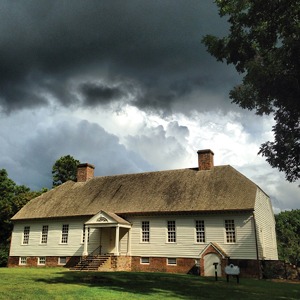 Scotchtown
Scotchtown
for Revolutionary Relevancy
Patrick Henry’s original one-story house from 1720 is as architecturally unique as Henry was patriotically unique, for the eighteenth century was an era of overwhelming two-story Georgian homes. Earlier this year, tours of the home, located eleven miles northwest of Ashland, shifted from the house to an emphasis on details of the fiery statesman and the legacy and relevancy of Henry in the twenty-first century, where revolution is practically a global constant.
The house museum is well-suited for families with kids about twelve and up. Guides explore concepts such as the different meanings of liberty throughout history – as in the rights of slaveholders to keep their property versus the enslaved man or woman’s desire to be free.
Jennifer Hurst-Wender, Preservation Virginia’s chief of operations who oversees the management and interpretation of Scotchtown, shows an image from Beijing’s Tiananmen Square with Chinese protesters standing beneath a “Give me Liberty or Death” banner to illustrate how Patrick Henry’s words still resonate around the world.
“We show him [Patrick Henry] as instrumental in the passage of Virginia’s Bill of Rights, which became the model for the U.S. Bill of Rights [added to the U. S. Constitution in 1781], something important for any young democracy,” Hurst-Wender says. “We point out how this relates to the present Universal Declaration of Human Rights.”
Guides use the rooms and furnishings to show Henry’s life as split between passions for family and country. The living room illustrates his personal life as a violinist and poet, with stories of his grandchildren falling all over him. The fact that he fathered seventeen children with two wives gets the attention of schoolchildren as well as adults. The concept of mental health hits home when we learn that his first wife, Sarah, who lived with mental illness, was kept in the basement with a caregiver at Henry’s request. Henry maintained that she received better treatment at home than that provided by eighteenth-century hospital wards for the mentally ill.
Henry’s bedchamber, with its bowl of snacks (nuts and marzipan candies), illustrates his work on documents late into the candlelit night. The home’s formal receiving room, where he talked to law clients, politically influential men and churchmen, focuses on his political career, his public voice – resistance to Great Britain’s Stamp Act, rise and involvement in Virginia’s Ratifying Convention (for the Constitution in 1788) and his influence in passage of the Statutes of Religious Freedom. Life was hard and full for committed patriots. Henry’s thirty-mile ride on horseback from Scotchtown to St. John’s Church took a full day.
Next year will bring more updates inside the house and continued re-focusing of the tour. Meanwhile, visitors can enjoy the picnic pavilion and birding trail and take a tour using a smartphone as a guide, even when the house is closed after December 28 (except for group tours). Outside, the sheep aren’t for petting. Managed by the South Anna 4-H Club, they’re for historical ambiance. Holiday visitors will note tents on the grounds as AMC is filming Turn at Scotchtown and the historic estate is serving as George Washington’s headquarters in the Revolutionary War series.
16120 Chiswell Lane, Beaverdam
804-227-3500
preservationvirginia.org
Museum admission: general, $8;
seniors, $7; AAA members, $6.
Children under six and members, free.
photos courtesy: Patrick Henry’s Scotchtown
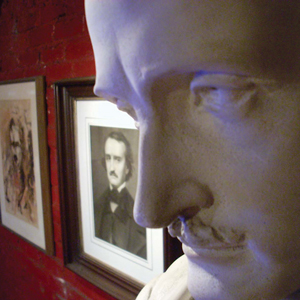 Edgar Allan Poe’s
Edgar Allan Poe’s
Legacy in Richmond
Lovers of Edgar Allan Poe’s creepy short
stories and who-done-its naturally gravitate to the museum at 1914 East Main Street celebrating America’s first internationally influential author. Teenagers looking to impress their teachers might want to emulate his poetry, but the kids who are more interested in hitting the right lunch spot or getting back to their mobile devices are definitely a challenge for guides.
Murray Ellison, a volunteer guide who is known as a working board member at the museum, gets his share of eye-rolling teens. “Teens are tough, but I always try to get them to see Poe as real, like themselves,” says Ellison. He’ll ask teens if they have ever felt unloved. Or if can they imagine, at age thirteen, being married to someone twice their age, as was Virginia Clemm when she married Poe. “I also try to find specifics to engage them – Poe’s hair, his childhood bed, his swimming up the James River for six miles against the current,” says Ellison.
Not just for literature geeks, the Poe Museum offers every bit of the romance and mystery that the author, poet, editor, and literary critic was himself known for: letters to and from his loves; manuscripts in his handwriting about women who returned from the dead to connect with him; documents about his mysterious death; and clothing and possessions from life with a wicked adoptive father, John Allan, with whom he lived in various Richmond homes.
The Poe Museum opened in 1922 in the Old Stone House, built around 1740 and considered the oldest original building in Richmond. The Old Stone House is many blocks away from where Poe lived with the Allan family at Moldavia (no longer standing); but a visit to this museum in Shockoe Bottom offers a journey back to early nineteenth-century Richmond, Poe’s era. The displayed scale-model of the city at that time, which captures even the slope of Richmond’s hills, captivated our own children and granddaughters long before the fourth or fifth grade (a good age for a visit), but then our family has always enjoyed crafting miniature buildings. Walking tours of Poe’s neighborhood with museum curator Chris Semtner are another great option for learning about the era as well as the man. The museum is very accommodating, with guided tours upon request (and regularly scheduled ones in the afternoon) and tailored scavenger hunts arranged for groups with advance notice.
The museum boasts the world’s finest collection of Edgar Allan Poe’s manuscripts, letters, first editions, memorabilia, and personal belongings; but it doesn’t own the wedding ring in which Poe had his name inscribed for his fiancé at the time of his death, Elmira Shelton. The ring, part of a private collection in New York, is on Semtner’s wish list for the museum – especially as no one knows the whereabouts of the wedding ring Poe gave his first wife, Clemm. “We do keep receiving significant donations – such as more articles of Poe’s clothing given to us recently,” Semtner says.
Perhaps that wedding ring will turn up as a Christmas present to the museum!
1914-16 East Main Street, Richmond
804-648-5523
poemuseum.org
Museum admission: general, $6;
seniors and students, $5;
members, free.
photos courtesy: Poe Museum
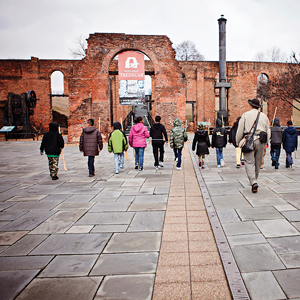 The Civil War
The Civil War
Explored in Richmond
About this time last year, the American Civil War Center (ACWC) and the Museum and White House of the Confederacy (MOC) announced they were joining forces to create a new Civil War Museum in Richmond, combining the ACWC’s historic site at the Tredegar Iron Works with the MOC’s unparalleled collection of artifacts to help visitors better understand the Civil War. On a recent visit I learned they’re already using their new name, the American Civil War Museum, with three sites, including the Museum of the Confederacy in Appomattox, with the White House of the Confederacy as the only present site to retain its name. I got a sense not only of how the new museum will capitalize on the strengths and legacies of each institution, but how it will be more appealing to families.
Big things are on the horizon for this group, but families can gain a lot from visiting now and seeing how the stories in each museum play off each other. The first thing one grasps at the MOC is that it isn’t all guns and swords. Twelve-year-old Girl Scouts, according to MOC public relations manager Sam Craghead, are touched by Richmond sculptor Moses Ezekiel’s statue on the MOC’s first floor, “Virginia Mourning Her Dead,” in memory of the VMI cadets who died at the Battle of New Market. Adjacent to the statue, younger children look for the mascot, “Tinker,” on the deck of the 1/8-scale blockade-runner, Armstrong. Two 1863 flags made by a 13-year-old girl and her older brother are also notable.
Visitors interested in the extensive research done on items (collection began in 1890) will be impressed by the provenance at the MOC, such as the history of an unidentified girl’s portrait found on the Port Republic battlefield. From dolls used for smuggling medicines, to a three-way Currier & Ives portrait, to a rosette formed by two bullets meeting in mid-air at Spotsylvania Court House, the Knickknackery is a good room to hit with kids.
The White House of the Confederacy is a rich story because a real family lived there. Even preschoolers enjoy seeing the nursery with its wooden rocking horse, dolls, and other period toys. The Confederate uniform for 5-year-old Little Joe Davis – whose life ended tragically with a fall from a White House porch on April 30, 1864 – lies on a child’s bed. Look for a specific family tour to be launched next summer.
In visiting the ACWC later the same day, I noted a few details from the White House that melded with exhibits here. For example, a lock of Lincoln’s hair in a frame on ACWC’s first floor reminded me that reporters at the White House of the Confederacy recorded seeing Lincoln through the front window as he sat on a couch during his April 5, 1865, visit to Richmond after Jefferson Davis’s family had fled.
The ongoing ACWC program, “American Lives, Richmond Voices,” has hands-on components appropriate for middle-school students. “Everyone’s story is intertwined,” says Stephanie Arduini, director of education, specifically noting artifacts related to U.S. Colored Troops when asked about them. The pull-tabs and flip pieces in Tredegar’s exhibits help tell the nineteenth-century industrial story, with a large selection of iron items.
Museum & White House of the Confederacy – 1201 East Clay Street, Richmond
804-649-1861, ACWM.org.
Museum admission:
MOC or White House only, adults, $10; seniors 62 and older, $8. Combined, adults, $15; seniors 62 and older, $13. Youth 7 to 13, MOC or White House only or combined, $6.
Civil War Center –
500 Tredegar Street, Richmond
Museum admission:
Adults, $8; youth 6 to 17, $4; seniors, $6.
Members, children under 7, and active-duty military are free.
photos courtesy: Penelope M. Carrington, The American Civil War Museum
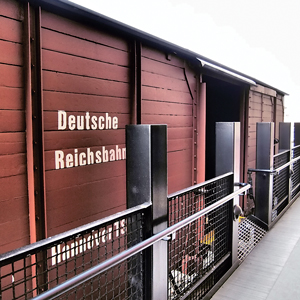
Virginia Holocaust Museum
What History Teaches Us
This museum with its austere, gray exterior and the somber VHM flag, requires more preparation for a visit than the other five museums combined – but the preparation and follow-up make the experience extremely worthwhile. Virginia Holocaust Museum staff recommend that before coming, visitors view the two videos on the museum’s website, which were made by Richmond holocaust survivors Ted Lehman and Alan Zimm. In front of the museum sits a boxcar that might have been used to transport Jews from all over Europe to Hitler’s gas chambers. Donated through the relationship of Holocaust survivor Alexander Lebenstein of Richmond with a group of German schoolchildren, it serves as a moving introduction to the museum in an old tobacco warehouse on East Cary Street.
The museum isn’t appropriate for children under age eleven, and adults might want to preview specific exhibits of graphic concentration-camp images before children see them. In a gentle attempt to explore the terrible history with middle schoolers, consider watching the 1997 Italian film Life Is Beautiful, in which a bookshop owner uses his fertile imagination to shield his son from the horrors of life in a Nazi concentration camp.
One of the best learning experiences for students visiting the museum is walking through a lighted tunnel and witnessing how a Jewish family lived underground when it was unsafe to live on the streets of Hitler’s Germany. The Children’s Memorial carries the names of children who died in concentration camps, though obviously only a fraction of the 1.5 million of them. The Tower of Remembrance serves as a memorial to family members of Richmonders who died in concentration camps. The Survivors’ Room is devoted entirely to Richmond survivors. In the Nuremberg Trials exhibit, visitors can read media accounts from newspapers and listen to audio from the proceedings.
As it is today, art was an important means of expression for children of all ages. Artwork by children who lived and died in the concentration camps is on display at the museum. As part of a community outreach program, VHM sponsors an annual art contest for Richmond-area middle school and high school students. Each year, the winners are displayed in the lobby.
Returning visitors will be interested in the museum’s first of a four-year update in its exhibit areas. Easy-to-read new panels were added in the front part of the museum this year, and updates in other areas will be made over the next three years.
2000 East Cary Street, Richmond
804-257-5400
va-holocaust.com
Museum admission is free.
photos courtesy: Virginia Holocaust Museum


